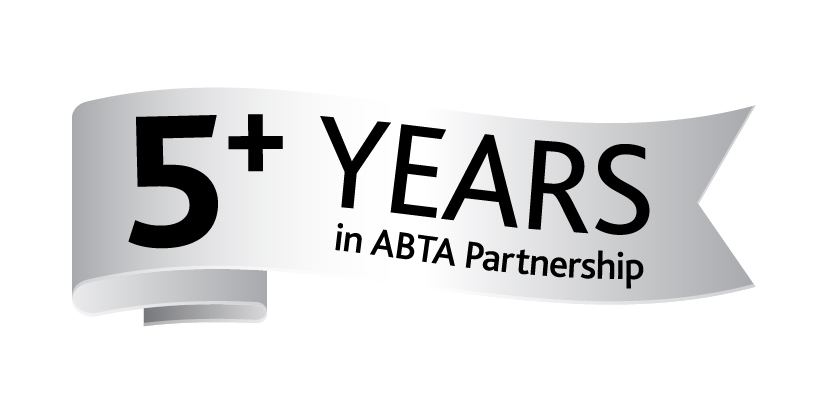As AI mode starts to appear in the UK after the initial roll out in the US, I’m struggling to work out what happens from this point onwards. I’ve built my career on the relative consistency of Googles search results pages. Type in query, get list of links, measure clicks and performance. It’s been this way since my early talks for the now defunct Business Link back in the 00s until a year or so ago when AI overviews first hit.
Since then, more and more organic traffic has stayed on the Google results page with Google having greater control over where to push users to click. When AI Mode was announced in spring 2025, a more horrific version of the search results page was previewed, one which effectively removed all clicks, replacing links with answers of varying quality. The insane hype and growth of ChatGPT and other LLMs sounded a ‘code red’ in Google a few years back and AI Mode was their attempt to match fire with fire with their new and fast-growing competitors.
But the behaviour of AI Mode is a complete step change in what has been the deal of the web for decades. Marketers create great content which is found by Google, it makes them look great, they get some money from paid ads and we get the traffic. AI Mode (and AI Overviews to some extent) break that model. It’s an incredible change for users but also Google.
What happens next? Some agencies or people with something to sell will tell you that this is the future of Google and you NEED TO ADAPT OR DIE! But c’mon now, Google can’t do just do that. Here’s why.
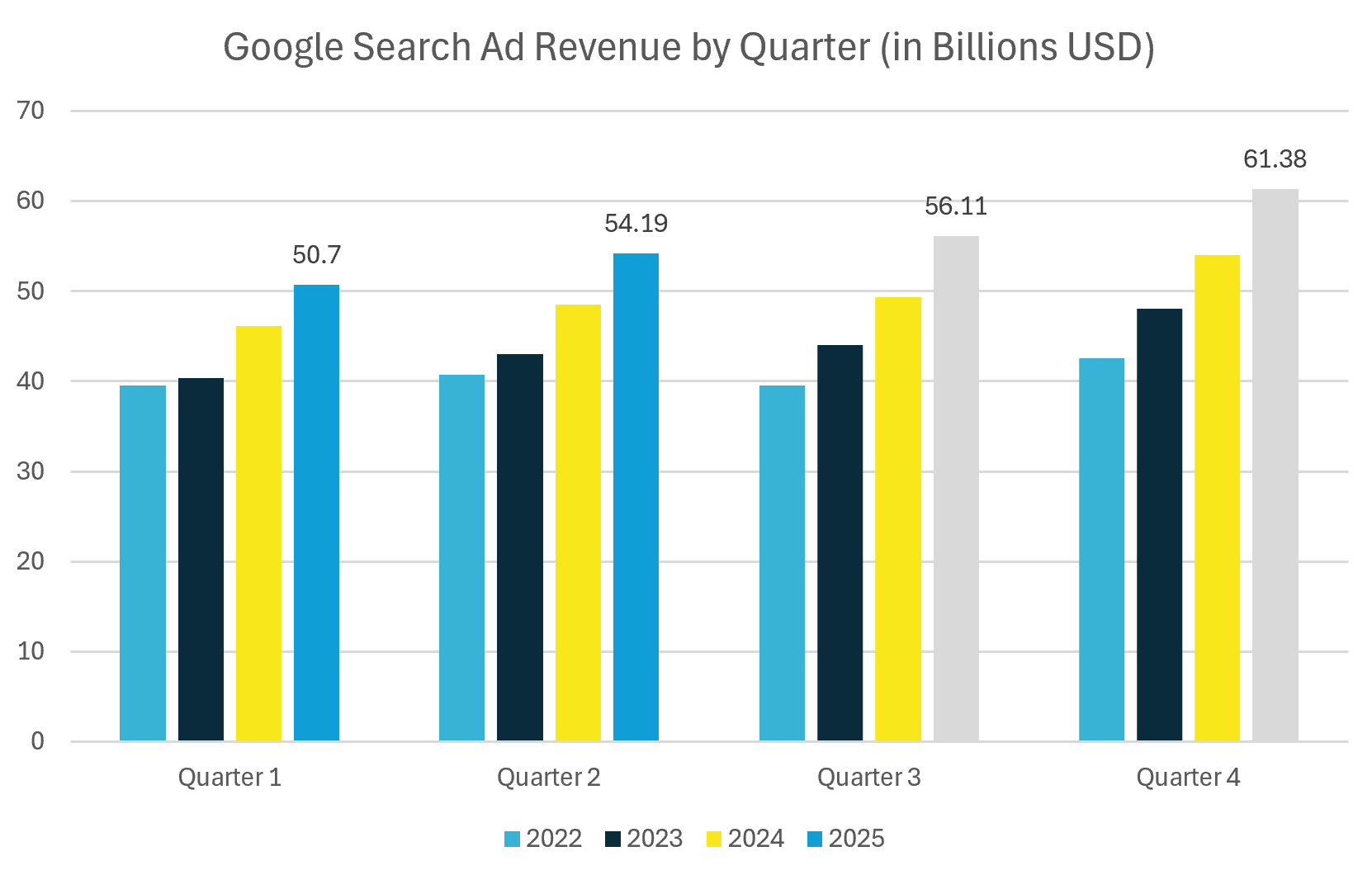
As we can see here, Google gets a LOT of money from search ads. They announced in the last month that Q2 2025 bought in nearly $55 BILLION in three months. That was a ~13% increase on the same time last year, as it was in Q1 this year. If they carried this on into Q3 and Q4, which is usually boom time given the Christmas run up, it could well be £60 billion at the end of the year.
When it comes to golden geese, well, they really don’t come much bigger than that.
AI Mode is a complete gamechanger in how Google presents information. Gone are the links. Gone, seemingly for now, are the ads. Gone are the clicks. Initial reports show that traditional clicks through rates of about 25% drop to about 5% when AI mode is used by users.
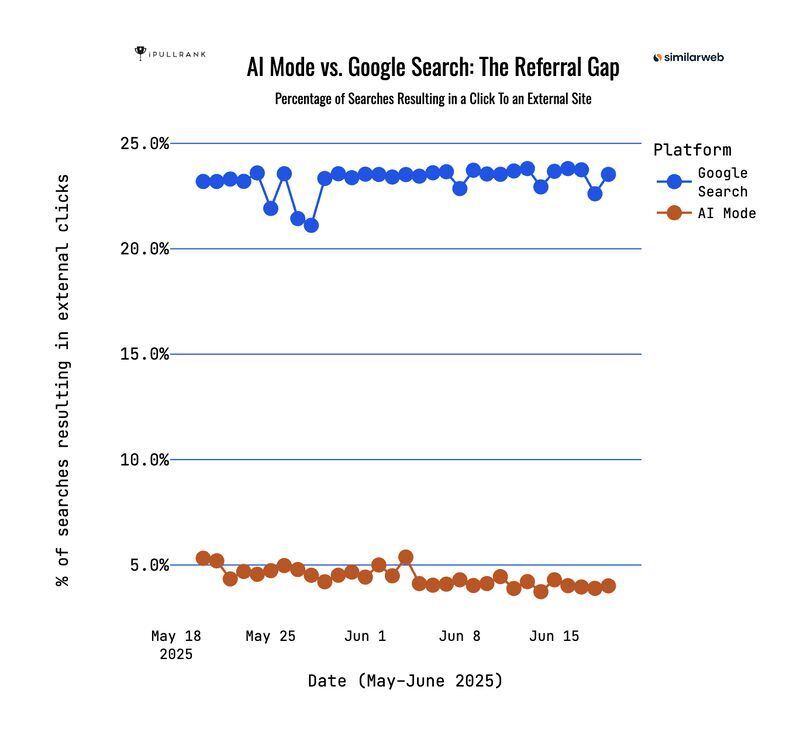
If you open LinkedIn and see people gushing about AI Mode, they are convinced that chat interfaces are the only future of the web, purely because ChatGPT has grown so quickly and that Google has their own version ready to go. Maybe they are right.
But if they are, then how does Google balance their core product losing 80% of its clicks? Will they really go in, all guns blazing to ‘kill off the competition’ like I’ve heard some in agency world predict? Not on your nelly. Shareholders need their growth. Employees need results to hit their targets. And frankly, I don’t think my parents are ready to put up with a new version of Google that is so radically different to the one that they’ve used for a decade or more.
What next for Google SERPs?
Here are three options that Google can look at.
1. AI Mode for answers, web guide for everything else
AI mode is great at answering questions in the same way that AI overviews have done so far but obviously in far more detail. Had Google come out with this first a few years back, I think we’d all be fawning over such a revolutionary way to find and consume information. Now, I dunno, it just sort of feels a bit like we've seen it all before. And as we’ve had GPT and others for years now, we know that these LLMs just ‘know’ pretty much everything. At Adido, we’ve had a mindset of ‘if the machine can make it, we shouldn’t’ for a long while now and for so many small publishers relying on clicks and ad revenue, the game has probably been up for a while now. LLMs can answer pretty much any basic ‘how’ or ‘what is’ question.
For things that need a bit more discernment, and I put travel into that, then perhaps the latest version of the SERPs, ‘web guide’, will be the go-to. Google knows that users almost never go to page two of results, and will nearly always search again when finding the next version of their query. By trying to shortcut that into one page, web guide gives users a way to get more information into one page without multiple searches and potentially advertisers to reach perhaps a wider audience by bringing those ads through too. A potentially broader results page is what will help keep users on the page whilst answering the user question and still allowing traffic to flow through to websites without much AI involvement. A more traditional search experience, but one that is different enough to keep users clicking and money coming in.
2. AI Mode for paying subscribers, ‘normal search’ for everyone else
It would appear that despite ads running against keywords for the last two decades and creating one of the biggest companies in history, OpenAI has no plans to run ads against their results (although Google did also say this back in their early days). How will they ever make their current $300 billion valuation? Seemingly, by getting users to pay $20 (or maybe $40 in a few years’ time) a month rather than rely on ads or B2B product offerings. To get to their supposed of $50 billion on a target of $44 a month would require over one billion people to pay their $44 a month subscription. It seems like an incredible shift in user behaviour, the likes of which we’ve never seen.
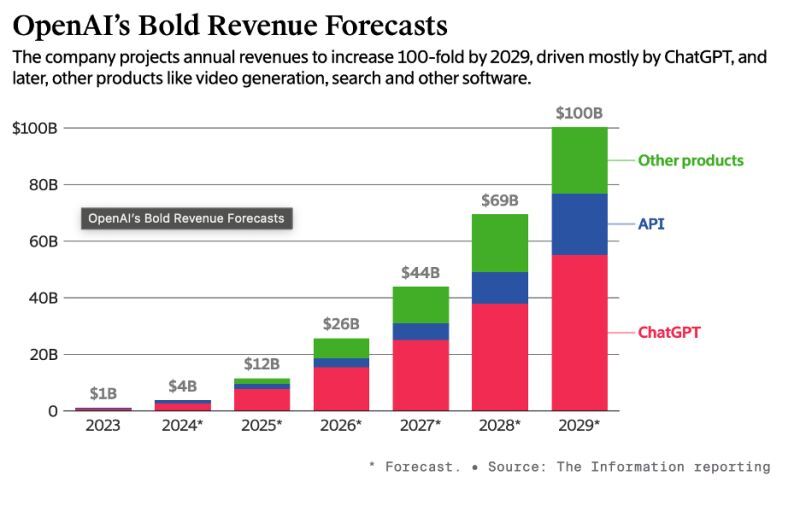
Perhaps then, this could come from businesses paying for ChatGPT for their staff which is another possibility, although with many free offerings out there (particularly from Google and Microsoft who already own the customer relationships), perhaps their predictions of numbers are just there to get their next funding round. Or perhaps not.
With current OpenAI subscribers at 16 million a month (sorry, that does sound ridiculous against a one billion user target right now), clearly someone out there is finding value in paying for subscription. What if these LLMs really are that useful and Google wanted to generate some more secure revenue without relying almost exclusively on ads? Perhaps bundling AI Mode or ‘Super Google’ with their Google One account would be a way of offering the enhanced Google experience but not at the loss of other revenue streams. Google One is growing in visibility across their properties from what I’ve seen this year (albeit very subtly) and for those willing to pay for a no/low ad experience, they can have it, at a price. There has long been talk of big tech providers charging to use their products without ads, perhaps with YouTube being the most successful at doing this with around 125 million subscribers in 2025 (although their pre roll ads are SO annoying, so perhaps not surprising!).
Is it possible that to keep revenue numbers high, Google is willing to slowly drop ads and put its premium search features behind a subscription paywall? If you had to pick between AI Mode with little/no ads + other Google Services for $20 a month and just ChatGPT, which one would you pick? Google could perhaps take away paying subscribers from a big competitor while keeping their revenue high and not having to try and squash ads into places where they aren’t wanted.
3. AI Mode for everyone & automated Google Ads
Whilst OpenAI have said that they won’t have paid ads at this point, we know that Google does and most likely will continue to do so. If the idea of wrapping up their ‘best’ search results into a subscription is perhaps a bit too much, perhaps they can build on their 20+ years of paid ads experience in a new world of limited clicks.
AI Max (the name makes me want to heave as much as what it actually does) has been launched this year and is rolling out across accounts through 2025 and beyond. If you’ve not heard of AI Max, you can read the propaganda, sorry, breakdown of it here from the horse’s mouth. Very simply, Google will start to create ads for your business based on AI ‘matching’ to help you reach more people without having to do the legwork. Could this mean AI Max is used to match your ads to users’ longer and more conversational queries that traditional search campaigns just can’t really cover? Can we imagine a world where next year the only way to target Google users with paid ads is via AI Max campaigns? Very much so.
What would be the effect? When you search for ‘what is the best car insurance for a 2006 renault for a 20 year old man’, you will a conversational reply, perhaps with several recommendations - some of which could well be paid ads like we have now, but as part of the answer. Would Google disclose which ones of the list are paid? Perhaps. It could just have a disclaimer at the end of the output to say ‘Google may include paid advertising answers’ or similar. Would the user care? Maybe... or maybe not.
And if advertisers know that they are getting less clicks, what are the options? Either pay more per click or, perhaps ultimately, use Google’s bidding tools which have been around for some years now, such as Target ROAS or Target CPA, where the Google machine pushes clicks to your website but you only pay if someone converts. They may be able to increase their overall revenue by charging a premium for highly targeted searchers who are far more prequalified by disclosing more information about themselves when they click out. The side effect of this of course, is that over time, smaller advertisers might miss out in the auctions when a more curated list is provided to users which will favour more ‘well known’ brands as they will be considered a ‘safer’ click to searchers. And if they are cut from the results, they might end up having to bid more to get back into the auction, ultimately only creating more value for Google.
For advertisers though, our control over the phrases, or conversations, that we appear in will gradually start to slip away. We’ve already seen with Performance Max campaigns that they are willing to go years hiding data from those running campaigns, with data and control about placements only coming into effect years after launch. In my presentations over the last 18 months, I’ve long talked about the fact that we are past ‘peak data’ as I call it – our keyword visibility in our ad campaigns has been on the wane for a long while and I expect AI Max to be another perfect hiding place for Google to do more shady tactics in the name of ‘privacy’.
A study by from Taikun Digital in 2025 showed that through Google’s hiding of hidden search terms, there was underperformance on budget ROAS of 18% overall on $20 million on ad spend. Going to this depth of analysis is very rarely done but just shows that if you pick apart the numbers on big ad spend, you’ll quickly find that there are forced inefficiencies at play which help Google make more money and are paid for out of your pocket.
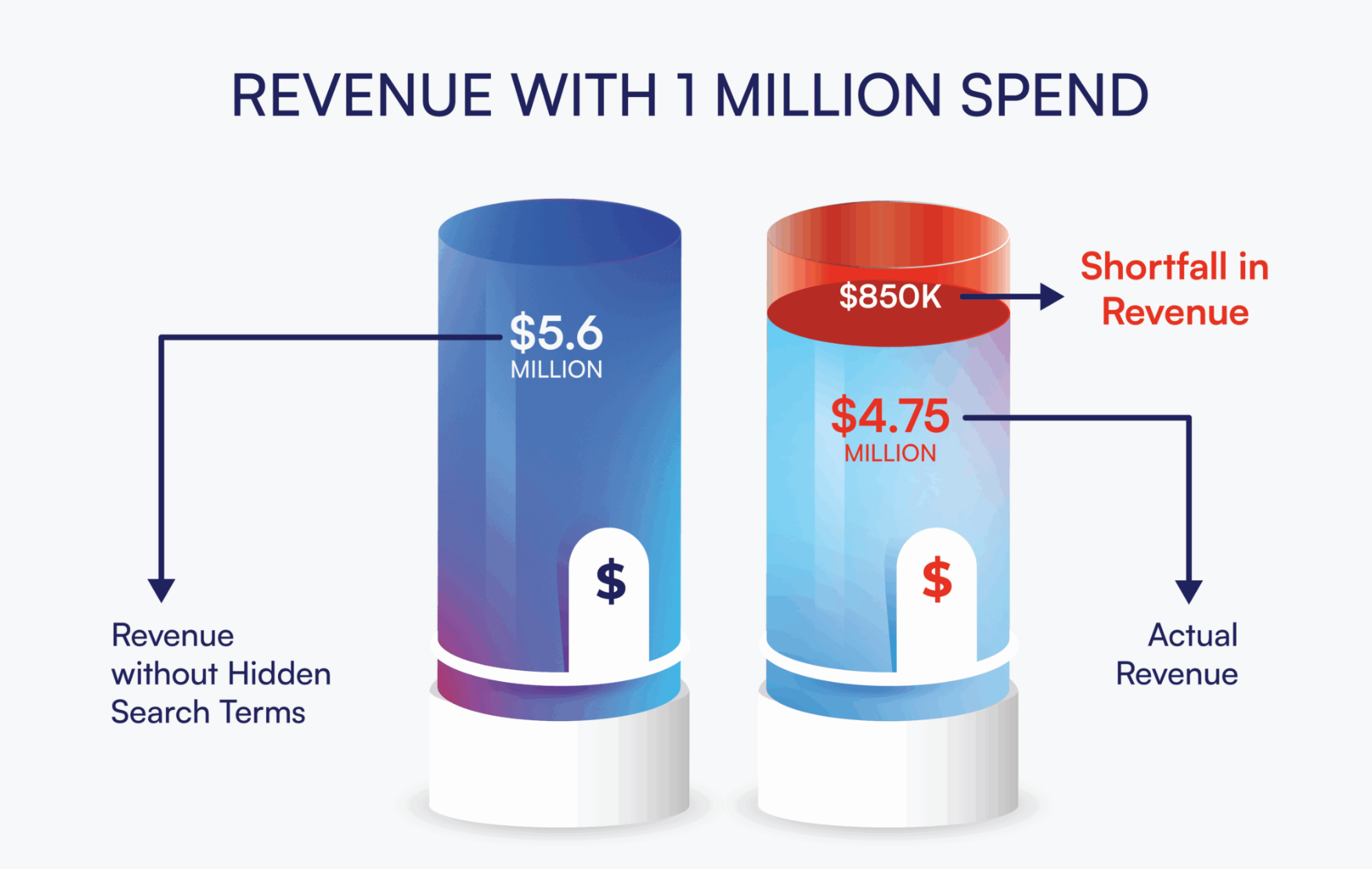
Image from Taikun Digital
I expect in time AI Max will show any ad to anyone on any platform in a bid to try and hit our leads/sales objectives and we’ll never really know what happened. In some ways, does it matter? The fact that, for decades before PPC, we never really knew if our newspaper or billboard ad was seen didn’t affect how brands were built and businesses grew. It’s only been since the turn of this century that we’ve started to measure everything and get obsessed about optimisation and keyword matching and other elements. If that goes away and we hit our business objectives, then I guess that’s a good thing, right? Potentially.
My biggest concern is that, despite our business success, the end traveller is ultimately served by a company that controls nearly every touchpoint. The phone you’re on? Owned by Google. The browser you’re on? Owned by Google. The search engine you’re using? Owned by Google. The results shown to you? Entirely created and owned by Google. The measurement tool you’re using? Owned by Google. The whole journey from start to finish owned by one company. And who audits what happens? Who can actually verify what’s going on? Only Google. In the past, at least we had keyword lists of phrases that we could see what matching had happened and make manual changes based on what we wanted to happen. In an AI Max world where I’m sure Google will push us to in the next 12-24 months, we’re going to get very basic data best about what happens and when.
If the graph above doesn’t convince you there is fishy stuff going on, then I suggest you follow Augustine Fou from Fou Analytics, as he’s produced more evidence and real data on Google’s recent Performance Max campaign types to show what’s really going on from real world campaigns.
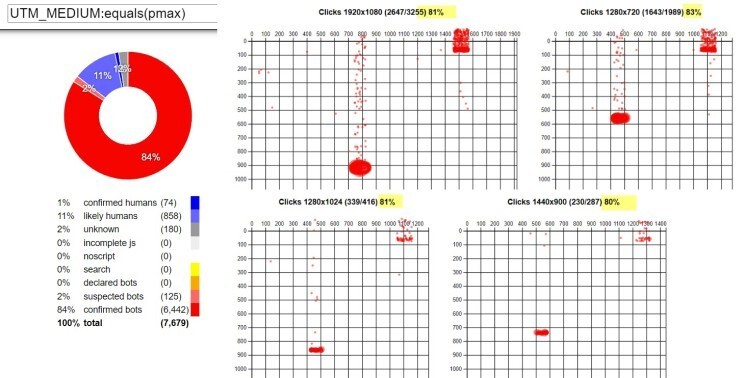
Image from LinkedIn
Whilst the rhetoric from Google will no doubt be ‘Look how this global blue-chip company gained 23% increase in sales from their PPC spend!’ on the ground, it’ll require a huge amount of learning and retraining about Google ads and what value it can bring, particularly to smaller businesses who will no doubt have a harder time in the auction and to make PPC work for them in the way it might’ve done in the 2010s.
UPDATE – we know as of 04/08/25 that Google will be allowing ads in AI Mode campaigns in Q4 2025 for certain advertisers but only for those running ads in AI Max and Performance Max campaigns, their largely black box, AI driven ad campaign types…
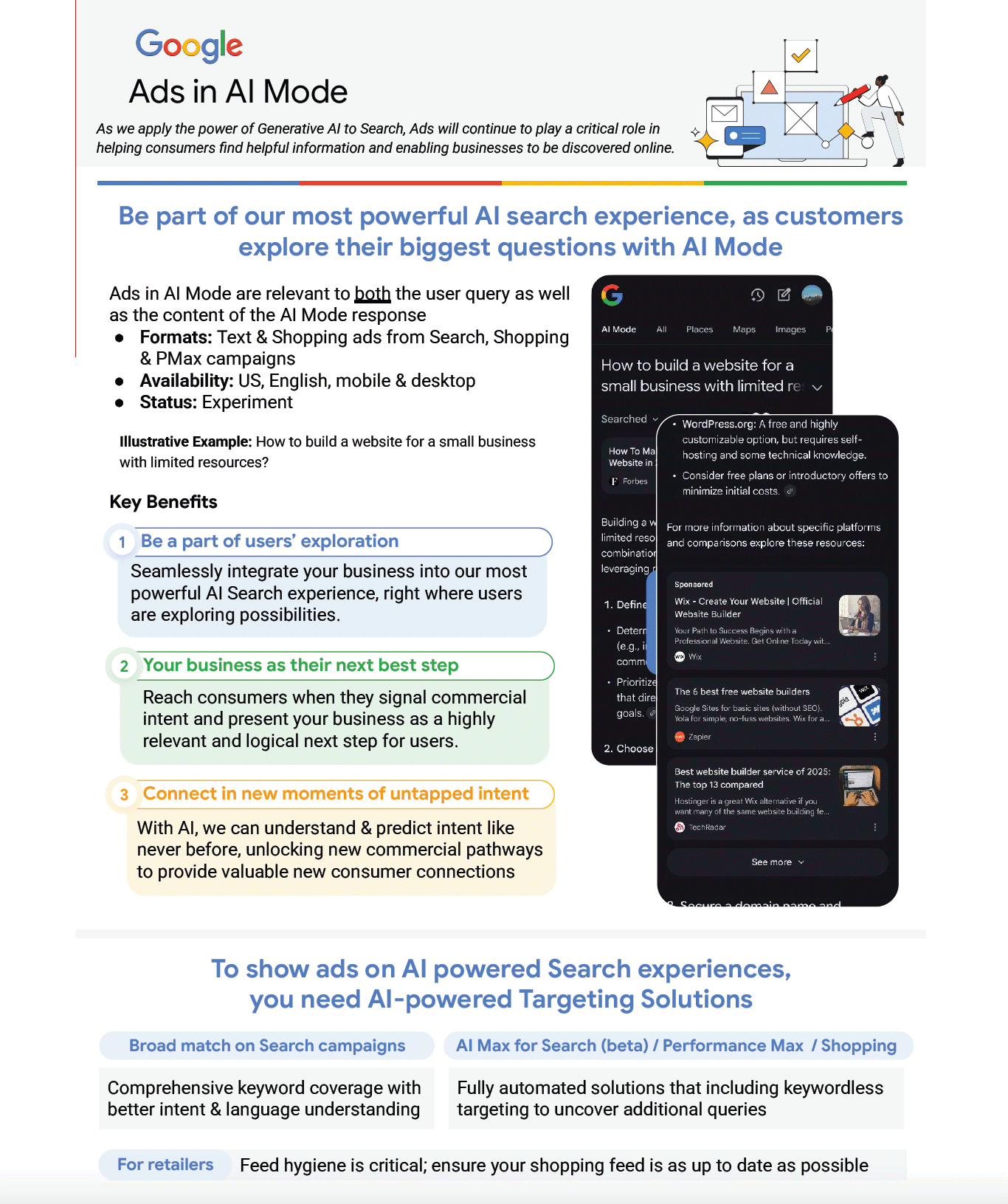
Big clickers get ads, everyone gets AI Mode
One gigantic reason why Google can’t be counted out in all the ‘ChatGPT will kill Google soon’ hype is that they have been honing search and user experience for two decades. All the LLMs have a few years’ experience in indexing, matching to user intent and other signals that help improve content. One thing they know more than anyone is who is more likely to engage with paid ads and advertising across the web. And they also have billions of registered users who are logged across the web too, thanks to the end-to-end data capture infrastructure they’ve built.
They know what you have clicked on, what you’ve searched on and with things like Google Pay, who you’ve shopped with and how much you’ve spent. This data has no doubt been used to help them target those more likely to click on ads over time and pull back on those that rarely engage with the various formats that they offer. Research carried out in the US in 2024 showed that there was a noticeable difference between Conservatives and Liberals when it came to who clicks on ads more.
“Within the marketplace of online information search, I argue that conservatives are likely to be more trusting of sponsored communications than liberals, who lean toward organic content.”
In a world of more polarisation politically, it’s easy to see perhaps how Google could serve up more ads to those people who read, watch or engage with more conservative tendencies and make more money from them. There are no doubt other groups of users in Google’s world who are clicking on more ads than other. An old study from 2009 found that ‘heavy clickers’ were creating nearly two thirds of the clicks on the web from just 4% of overall users. Whilst this research is old, it’s still very possible that there are some ‘super clickers’ out there who are generating a disproportionate amount of revenue for Google compared to ‘normal users’.
With everything becoming more personalised as time goes on, could it be that some users are kept on a more traditional SERP page (or one of the last ones to get AI Mode as default should that happen) to keep them clicking on more Google Ads whilst the majority of users slowly migrate over to AI Mode where they will occasionally click or purchase to generate income that way? If you have a golden goose group of users creating more value than others, then surely it’d make sense to do that?
So what?
This is all a lot of pontification, I appreciate that. Google obviously has a plan of what is going to happen in the coming years and no doubt most of it will be driven by AI. More work done with fewer people is always the plan with any business.
Perhaps AI mode will become the default in 2026? Perhaps after trailing AI mode with AI Max ads in 2025 and 2026, Google will realise that the transition is harder than they thought and will move to more a ‘web guide + AIO’ model to keep clicks and revenue coming in. Really, it’ll be us, the users, who decide what is best for us. If I know one thing, it’s that Google isn’t going to just jump headfirst into a new way of presenting search results to its users without collecting billions of pieces of data, analysing them and then deciding on the best move for itself and also those using their search bar each day.
My biggest message to you reading (if you’re still here) is that whatever happens, we will have far less control, far less reporting and no doubt bigger costs to bear as time goes on.
What to do? For a decade or more I’ve said that Google is your ‘frenemy’. Use it to help your business, not dictate how you run it. Acquire customers from them but look after these customers by nurturing them through your own channels like email, messaging and social. Heck, even send them a postcard once in a while. The more we can build our business through the channels we own rather than ones controlled by the big tech companies, the better chance we have of keeping our profit rather than giving it back to them.
And whilst I don’t want to give more data to Google and other big tech platforms, the reality is that they need to know what is going on in your business in order to help you succeed. The final thing to look at is building a good data platform that collects sales data and sends it back to Google so that it can optimise towards success rather than noise. If you can start sooner rather than later, when the big Google AI push happens, in whatever form it takes, you’ll be one step ahead of the competition for sure.





